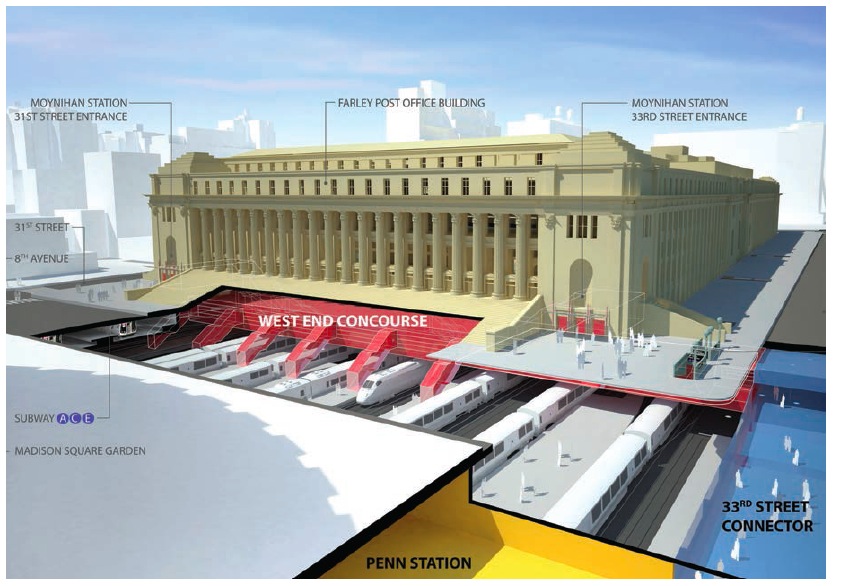NEW YORK BUILDING CONGRESS
New York City’s rail transportation system carries millions of commuters from across the region every day, undergirding an essential component of the United States economy.
The recent discussion about the future of Penn Station offered a unique opportunity to focus public attention on the rail system’s crucial importance to the economy and the mobility of the City, particularly on the emerging Far West Side of Manhattan. Unfortunately, this conversation failed to address the single most important problem the City faces around Penn Station: New York City’s rail connections to New Jersey and points north and west have remained essentially unchanged for more than a century.
This antiquated network is ill-equipped to transport the hundreds of thousands of commuters whose daily trips to work rank among the longest in the nation. Chokepoints in the system, such as the two, single-track tunnels under the Hudson, constrain further growth. Three major independent rail operators, Amtrak, New Jersey Transit (NJ Transit), and the Long Island Rail Road (LIRR), all use Penn Station as a key terminal, operating at full capacity during rush hours, with no flexibility to expand service in its current configuration.
While these conditions are reason enough to expand the West Side rail network, two transformative events now make it imperative. First, in 2005, the City’s Hudson Yards rezoning on Manhattan’s Far West Side permitted the creation of up to 26 million square feet of new commercial space, tens of thousands of new housing units, and millions more square feet of retail and hotel space. A new neighborhood is quickly developing to the west of Penn Station where none had existed before.
The soon-to-be completed extension of the #7 subway to Hudson Yards was necessary to spur initial development, but as millions of square feet of new commercial and residential space come online there, existing rail service will be hard pressed to meet this new demand when it is already one of the most congested parts of the rail system.
Second, Superstorm Sandy offered a sobering lesson about the weaknesses of the City’s aging transportation network. The storm inundated most of the City’s commuter tunnels, halting access to the City for most of the 1.6 million workers who travel to Manhattan to work.
The storm’s immediate, harmful impact on the City’s economy was well documented. But perhaps more troublesome are its longer-term effects. The Metropolitan Transportation Authority (MTA) is closing the Montague Street Tunnel, connecting the R subway line between Brooklyn and Manhattan, for more than a year to repair damage caused from the storm. Fortunately, the thousands who use the R train can find alternative routes through transit-rich downtown Brooklyn.
This is not the case between New Jersey and Manhattan, where, astonishingly, only two single-track tunnels connect the entire commuter rail system to points west of Manhattan. There is no alternative rail route if these tunnels fail. New tunnels capable of withstanding severe weather events must therefore be constructed.
In this context of a growing workforce, the emergence of a major new central business district, and the threat posed by severe weather to the City’s aging rail system, the New York Building Congress endorses four critical transportation projects in and around Moynihan Station and proposes key steps necessary to implement them. The recommendations are ambitious, but the consequences of inaction are too high, and New York’s role as the nation’s economic center is too important to ignore.
The Solution: Four Core Projects
If implemented, four long-discussed, interconnected projects would solve the challenges outlined above by creating a more expansive, efficient, and resilient rail transportation network. The four projects fall under multiple local, State, and federal jurisdictions, so coordination and consensus are essential to bring them to fruition.
- 1. Complete Moynihan Station
- 2. Build the Amtrak Gateway Project
- 3. Create West Side Access for Metro-North Railroad
- 4. Complete the Penn State Vision Study and Plan for its Implementation
Download full version (PDF): Moving Midtown West
About New York Building Congress
www.buildingcongress.com
“The New York Building Congress…is committed to promoting the growth and success of the construction industry in New York City and its environs. The Building Congress provides a unique forum to advance an industry-wide agenda focusing on economic and infrastructure investment, job creation and professional exchange. These goals require the dedicated involvement and cooperation of the contractors, architects, engineers, unions, real estate managers, developers and owners who comprise the building community.”
Tags: LIRR, Metro-North Railroads, New York, New York Building Congress, New York City, NY, NYBC, Passenger Trains, Regional Rail







 RSS Feed
RSS Feed